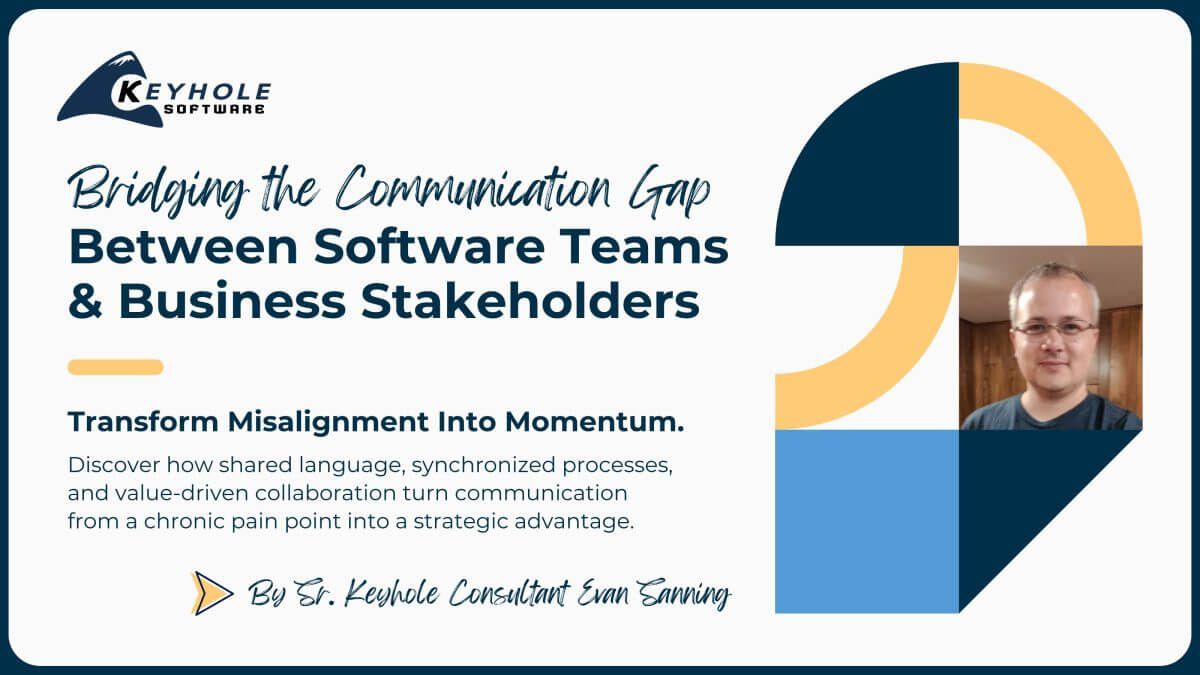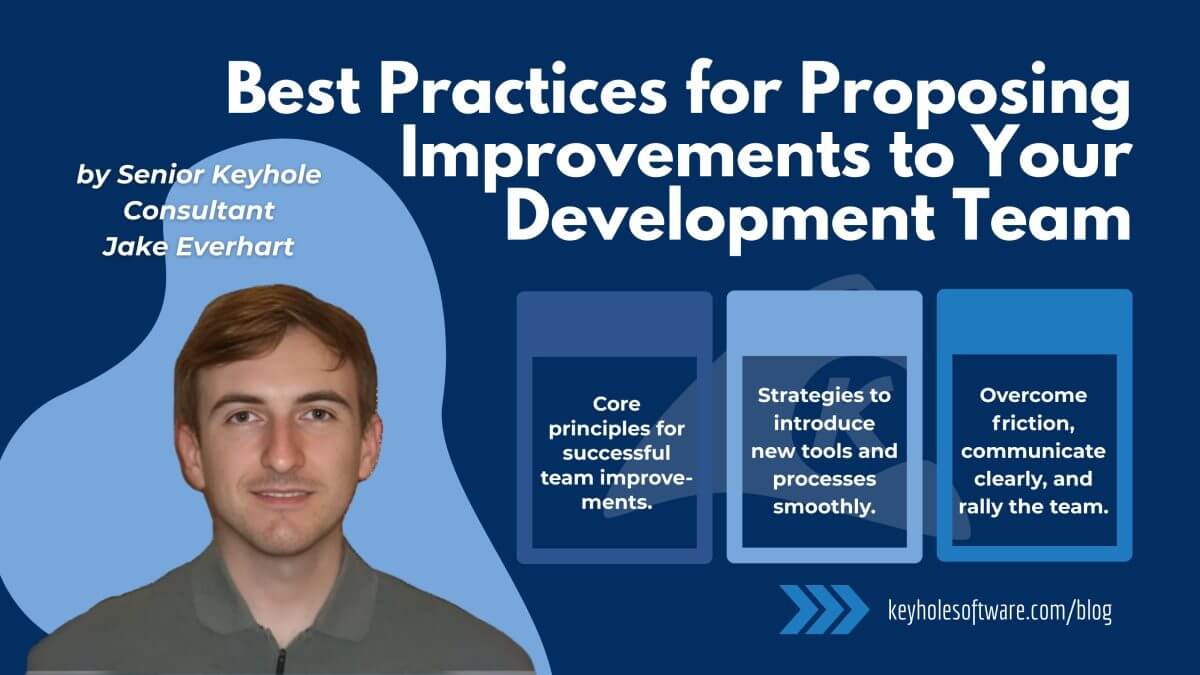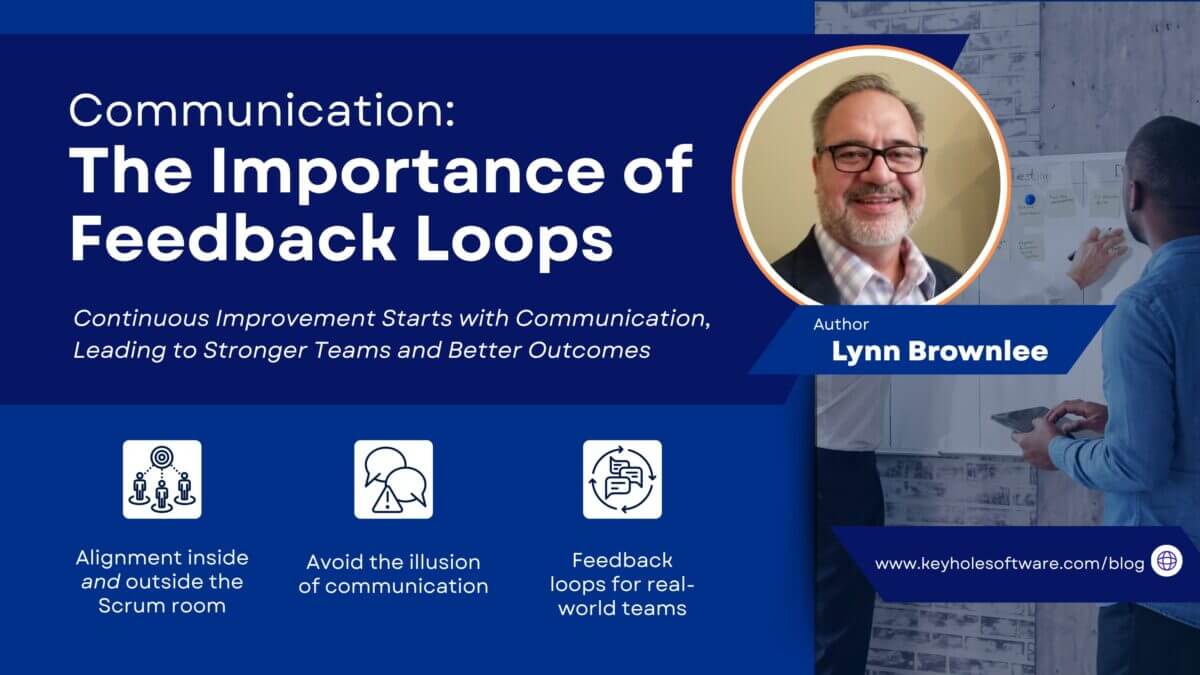
The Foundations of SAFe: Part II (Core Principles)
September 26, 2024
Welcome back to Part II of our series covering Scaled Agile Framework. As a quick refresher, I’m a lead consultant at Keyhole Software, and for the past year, I’ve been helping my client adopt SAFe methodologies and practices. I’ve certainly learned a lot, and I want to share that knowledge with you.
Last time in Part I, I gave an overview of SAFe and discussed the four core values: Alignment, Transparency, Respect for People, and Relentless Improvement. Today, we’ll dive a little deeper, talking through SAFe’s ten core principles. Next time in the third and final installment, we’ll take a practical look at the pros and cons of SAFe and some tips for implementing it.
Let’s get started.
SAFe Core Principles
SAFe is built on ten Core Principles, which serve as the foundation for implementing the framework and guiding organizations in their agile transformation journey. These principles help organizations adopt an agile mindset and promote continuous improvement, delivery of value, and alignment with business goals.
We will discuss each of the ten principles in detail below. First up: taking an economic viewpoint.
1. Take an Economic View
Taking an economic view means that decisions should be made based on the economic advantage of the organization. First, remember that transparency is key: it’s important that the whole team truly understands the financial implications of their actions, which starts with open communication and information sharing. As they weigh the various options and strategies, encourage your team members to evaluate the economic trade-offs, considering factors like customer value, time-to-market, costs, and risks.
Second, focus on maximizing the flow of value to customers while optimizing the cost and speed of delivering that value. Simply put, prioritize the work that brings the most value to the business, and train your team members to do the same in their daily work. Remember, though, as tempting as it is to use outputs (e.g., features delivered) as a measurement for efficiency, emphasize the importance of outcomes instead. Outcomes like customer satisfaction, revenue growth, and more are stronger indicators that the work being done aligns with the economic goals of the organization.
My final piece of advice is to always, always optimize for the whole. Ensure that all decisions are made in the best interest of the entire value stream or organization, rather than optimizing individual parts in isolation. Keep the big-picture goals top of mind, even when making seemingly small, everyday choices, and train your teams to do the same.
By taking an economic view, organizations can become more efficient, adaptive, and responsive to changing market conditions while delivering greater value to customers and stakeholders. It encourages teams and organizations to make decisions that are financially sound and aligned with the overall goals of the business.
2. Apply Systems Thinking
Applying systems thinking identifies the importance of understanding how different parts of an organization interact and influence each other as a unified system. Systems thinking stems from the Systems Management Theory, which proposes that an organization is sort of like the human body. A body is made up of multiple subsystems – organ groups, organs, tissues, and even individual cells – that must all work harmoniously so that the larger system can flourish. Similarly, the subsystems of an organization – departments, teams, individual employees, and even processes – must work harmoniously together so that the organization can perform optimally.
Fostering a sense of interconnectedness is important in SAFe practice. Recognize that the various components of an organization (teams, processes, technologies) are interconnected and interdependent. Changes in one area can have ripple effects across the entire system, so steps must be taken to mitigate or explain impacts.
Because subsystems are interconnected, identifying and leveraging feedback loops facilitate continuous improvement. Feedback from one part of the system can influence decisions in other parts, and it’s critical to learn how to collect and use feedback from your teams (hint: creating a culture of respect that encourages open communication is critical here). When negative feedback (or challenges/issues) arise in one subsystem, remember to look for root causes that stem from interactions within the system, rather than focusing solely on symptoms.
Systems thinking reminds us to take a holistic view of the organization, understanding how different parts of the system impact each other and the overall outcomes. Focus on how subsystems interact with the entire system rather than optimizing individual components in isolation. Align goals and activities across different subsystems so that the entire organization is in harmonious peak performance.
3. Assume Variability; Preserve Options
Assume variability; preserve options acknowledges the inherent uncertainty that organizations face when developing products and solutions. Real-life situations are never completely predictable. We’re not machines! There will always be variability and unpredictability in the development process due to changing requirements, market conditions, and other factors.
So, it’s important to avoid overly rigid plans that cannot adapt to change and to keep multiple options open for as long as possible to allow for flexibility and adaptation in response to changing circumstances. This mindset also helps with risk mitigation by maintaining the ability to pivot or adjust strategy in response to unforeseen events.
Another tip I have for this one is to decentralize decision-making. Rather than having an authoritarian management style, empower teams to make their own decisions (at the appropriate level of course), so they can respond quickly to changes without needing layers of approval. Encourage an agile mindset that embraces change and welcomes new information as opportunities to learn and improve. Iterate frequently, gather feedback, and adjust plans based on new insights.
Overall, this principle encourages organizations to remain adaptable and resilient in the face of variability and uncertainty, preserving the ability to make informed decisions based on the most up-to-date information available.
4. Build Incrementally with Fast, Integrated Learning Cycles
Build incrementally with fast integrated learning cycles is the importance of delivering value in small increments while continuously learning and improving. This starts by breaking down work into small, manageable increments or iterations that can be built, tested, and delivered quickly. Both feedback loops and continuous integration, testing, and delivery are important here! Set up rapid feedback loops and automate processes wherever you can.
Fostering a culture of continuous learning and improvement is also critical here. Encourage teams to test hypotheses through experiment, gather feedback, and apply learnings to future iterations. Create an atmosphere of innovation by encouraging open communication and respecting your team members’ diverse perspectives.
By building incrementally with fast integrated learning cycles, organizations can reduce risks, adapt to change more effectively, and deliver value sooner. This principle promotes agility, responsiveness, and a focus on continuous improvement throughout the development lifecycle.
5. Base Milestones On Objective Evaluation
Base milestones on objective evaluation of working systems is the importance of measuring progress and success based on tangible outcomes rather than subjective assessments. Define milestones based on the delivery of functional systems, use objective criteria to evaluate performance, and be transparent about criteria and evaluations throughout. This ensures that progress is measurable and tied to tangible deliverables and that every team is aligned with the organization’s overarching objectives.
Another piece of this is, again, feedback. Use feedback from working systems to drive iterative improvements, and incorporate it into the planning process to adapt plans and milestones in response to changing circumstances or priorities. Focus again on objective, data-driven insights to inform decision-making.
A final tip for you is to regularly demonstrate working systems to stakeholders to provide visibility into progress and gather feedback. This helps ensure alignment with stakeholder expectations and allows you to pivot earlier if needed.
By basing milestones on objective evaluation of working systems, organizations can make more informed decisions, track progress effectively, and ensure that development efforts are aligned with business objectives. This principle promotes accountability, continuous improvement, and a focus on delivering value to stakeholders.
6. Make Value Flow without Interruptions
Making value flow without interruptions focuses on optimizing the flow of value through the organization’s development and delivery processes. Start by identifying and mapping out end-to-end value streams that represent the steps required to deliver value to the customer. Then use those maps to eliminate waste by streamlining processes, reduce batch sizes to shorten lead times, and automate wherever possible (CI/CD) to accelerate the flow of value.
You should be using a visual management tool (like Kanban boards) to make work visible in real-time. These help teams optimize flow and allow managers to more readily monitor and measure progress and value add.
This may sound counterintuitive, but be sure to set limits on work in progress to prevent overloading teams. Teams and individuals should focus on completing work before starting new tasks. You’ve heard the saying, “How do you eat an elephant? One bite at a time.” That’s the idea here.
Lastly, empower cross-functional teams to make decisions and take ownership of their work. By decentralizing decision-making and encouraging autonomy, teams can respond more effectively to challenges and keep the flow of value continuous.
Overall, making value flow without interruptions in SAFe aims to create a smooth, continuous, and efficient flow of value through the organization’s development and delivery pipelines. By optimizing value streams, eliminating waste, and empowering teams, organizations can deliver value to customers more predictably and consistently.
7. Apply Cadence; Synchronize with Cross-Domain Planning
Apply cadence; Synchronize with cross-domain planning highlights the importance of establishing regular time intervals (cadence) for planning, execution, and evaluation across different domains or levels of the organization. This begins by setting and sticking to regular timeboxes planning meetings, reviews, retrospectives, and releases. Cadence provides a predictable rhythm for work execution and helps create a sense of discipline and structure.
Once a cadence is established, coordinate planning activities across teams and establish shared milestones and checkpoints, so work is aligned with organizational objectives and timelines. Use iterative and incremental development approaches to deliver value incrementally and (as always) adapt plans based on feedback. Iterative development allows for flexibility and responsiveness to changing requirements.
Applying cadence and synchronizing cross-domain planning improves coordination, alignment, and responsiveness to changes, ultimately enhancing the efficiency and effectiveness of operations. This principle fosters collaboration, transparency, and agility in planning and execution activities across the organization.
8. Unlock the Intrinsic Motivation of Workers
Unlocking the intrinsic motivation of knowledge workers means creating an environment that empowers and motivates individuals by tapping into their intrinsic drivers. Creating a culture that respects individuals (re SAFe Core Value #3) is where this takes flight.
Provide individuals with the autonomy to make decisions, solve problems, and take ownership of their work. Encourage continuous learning and mastery of new capabilities to enhance job satisfaction, and cultivate an environment where taking risks and learning from failure is ok. Foster a collaborative atmosphere that encourages knowledge sharing, feedback, and teamwork. Help employees establish a sense of purpose by connecting their work to a larger vision. Recognize and appreciate employees’ efforts, accomplishments, and contributions. Acknowledging and celebrating successes can boost morale, motivation, and job satisfaction.
By unlocking intrinsic motivation, organizations can create an engaging and fulfilling work environment that enables peak performance and drives innovation. This principle focuses on building a culture that values autonomy, mastery, purpose, collaboration, recognition, and continuous improvement to inspire and motivate employees.
9. Decentralize Decision-Making
Decentralizing decision-making means distributing the power of choice across the organization to empower teams and individuals at all levels. Empowering employees with decision-making power fosters ownership, innovative problem-solving, and faster responses to challenges. It increases agility and adaptability by allowing teams to make changes when the situation demands.
Successfully decentralizing decision-making is not an easy task. It’s critical to ensure that everyone is still aligned with the organization’s overarching goals and values. Although it’s distributed, decision-making should still be guided by the organizational mission and priorities. To mitigate the risk of falling off task as many people share in the decision-making processes, establish clear guidelines and boundaries from the get-go. Establishing healthy alignment is make or break for this principle.
By decentralizing decision-making, organizations can promote autonomy, innovation, and employee engagement while enabling faster responses to market changes and customer needs. This principle supports agile practices, self-organizing teams, and a culture of collaboration and continuous improvement within the organization.
10. Organize Around Value
Organizing around value means structuring the organization’s teams, programs, and initiatives to deliver value to customers effectively. Remember when we talked about creating value stream? Align teams and resources around those streams to ensures that work is focused on providing meaningful outcomes to customers, and coordinate cross-functional teams responsible for end-to-end delivery within a value stream.
Place a strong emphasis on understanding and meeting customer needs within each value stream; the customer should always be the focus. Optimize flow so that interruptions are minimized. Align work within value streams with the overarching business goals. Foster a culture of continuous improvement within value streams by encouraging teams to reflect on their processes, experiment with new ways of working, and adapt based on feedback.
By organizing around value, organizations can streamline their processes, improve collaboration, and ensure that their initiatives are focused on delivering meaningful outcomes to customers. This principle helps align teams, resources, and priorities to maximize the value generated by the organization’s products and services.
Until Next Time…
And just like that, we’ve covered the ten Core Principles of SAFe. These ten principles are guided by and truly stem from SAFe’s overarching Core Values, which we discussed last time in Part I. These Core Principles are meant to assist organizations in embracing an agile mindset while fostering continuous improvement, delivering value, and ensuring alignment with their business objectives. As a quick recap, the principles are:
- Take an Economic View
- Apply Systems Thinking
- Assume Variability; Preserve Options
- Build Incrementally with Fast, Integrated Learning Cycles
- Base Milestones On Objective Evaluation
- Make Value Flow without Interruptions
- Apply Cadence; Synchronize with Cross-Domain Planning
- Unlock the Intrinsic Motivation of Workers
- Decentralize Decision-Making
- Organize Around Value
Next time in Part III, we’ll get into the nitty-gritty, discussing SAFe’s benefits and drawbacks as well as some practical recommendations for both small teams and individual developers. We’ll also discuss criteria for determining whether or not SAFe is the right choice for your unique team.
I’ll see you soon!
More From Todd Horn
About Keyhole Software
Expert team of software developer consultants solving complex software challenges for U.S. clients.





